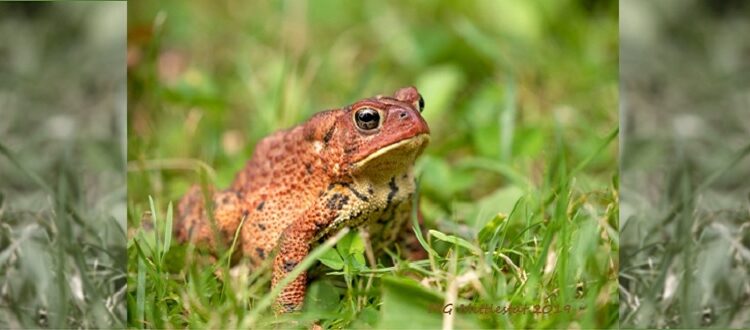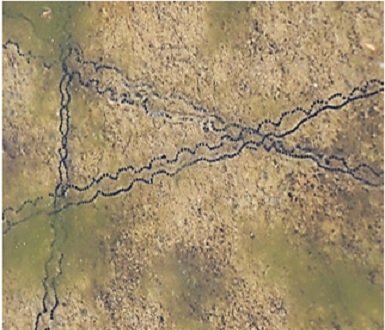CREATURE FEATURE – American Toad
A Grumpy Garden Helper
GET TO KNOW
Eastern American Toad
The Eastern American toad – with his bumpy skin and grumpy face – is the most common amphibian in the Rouge River watershed. He is a resilient little fellow – who has adapted to suburbia and taken up residence in ditches, fields, parks, gardens, and golf courses. Based on FOTR’s 2020 Frog & Toad Survey results, these toads were found in 83% of all sites surveyed. They were present in all seven of the sub-watersheds and across all four branches of the river.
FUN FACT – Frogs, with their long and powerful hind legs, are known for single jumps of impressive length. However, toads, with their much shorter legs, amble along with a series of small hops and can cover much longer distances when necessary. For example, each spring, toads may travel up to a mile to return to their favorite breeding pond.
Therefore, should you find a small, brownish toad sharing your yard, please offer a friendly welcome. This little toad is quite shy. It will try to stay out of sight while happily patrolling your yard for insects. However, please don’t spray pesticides. The toad needs the insects, and as an amphibian, the toad is susceptible to absorbing pesticides (and other chemicals) through its skin.
HABITAT AND LIFE CYCLE
For most of each year, adult American toads live solitary lives on land. They stake out individual territories within hopping distance of a favorite breeding pond (usually their own pond of origin). Throughout the warmer months, they spend nights hopping about – searching for their favorite meal of bugs, slugs, spiders, or worms – and days resting under rocks, logs, leaves and garden accessories.
Unlike many species of frogs, American toads have no ability to survive freezing temperatures. Therefore, they seek winter shelter underground and burrow below the frost line. Digging with their hind feet, they slide backwards into their den where they safely hibernate through the coldest months.
Come spring, when evening temperatures climb above 50⁰ F, American toads wake up. First things first, they seek a mate. Males head to ponds to carve out their own bit of breeding territory. Once situated, they begin a nightly chorus of trills, calling the females to the water. Check out this toad as he calls. Each male’s trill is a long (up to 40 seconds) and unique vibrating tone that not only calls the females, but also identifies the male and his familial lineage. Responding females are believed to select appropriate mates based on the information conveyed in the trills. In the toad mating process, known as amplexus, males cling to the back of the larger females and fertilize eggs as they are released. In the case of American toads, males are only about 2 inches, long while the females range up to 4 ½ inches long. Since female American toads release an astonishing number of eggs (estimates vary widely from 2,000 to 20,000 eggs per event), the amplexus process takes place over many hours. However, once the process is complete, both males and females return to their individual territories, and eggs are left unguarded. Predation of the eggs (and tadpoles) is severe. Only an estimated 10% of eggs ever survive to adulthood.
Female American toads release their eggs in long chains encased in goo. Surviving eggs hatch within two weeks, and the tiny tadpoles stick together, in large schools, for mutual protection. They feed on bits of vegetation as they slowly develop hind legs, front legs and lungs over a period of 1 ½ to 2 ½ months. Large groups of the tadpoles tend to complete the metamorphosis to tiny toadlets (as small as ¼ in long) at the same time. As new toadlets, they continue to stay close for protection, leaving the pond and traveling together in vast numbers before eventually dispersing to find individual territories.
Since life as a toad is dangerous, American toads employ a large number of defense mechanisms. First, they simply hide for most of the daylight hours, and their brownish/ grayish skin provides respectable camouflage against leaf litter when they live in woodlands. At night, when they do most of their own hunting, they may “freeze” (stay perfectly still) in an attempt to avoid the notice of a passing predator. These toads are also known to puff up with air to increase their overall size and inhibit a predator’s ability to swallow. However, if actually grabbed by a predator, American toads release both a foul-tasting urine, and an irritating toxin into the mouth of the predator. The many bumps on their skin (which are not warts) and the two large glands behind the eyes, release bufotoxin. This caustic toxin can irritate skin, eyes, and mucous membranes, and if ingested, can trigger heart arrhythmias in some animals (i.e.: dogs). Nonetheless, in spite of these defense tactics, both raccoons and snakes successfully prey on American toads.
Estimates of toad lifespans vary greatly because most tadpoles and young toadlets are captured by predators. However, toads are hardy creatures, and those that reach adult status may survive ten years in the wild. And, in the absence of predators, captive toads may live 30 to 40 years.
TAKE ACTION
Although American toads are quite adaptable, and currently considered a secure species, they still require sufficient natural habitats, with permanent breeding ponds and plentiful insects, for survival.
FOTR’s annual Frog & Toad Survey is in process now. During our survey, our volunteers go out at dusk to listen for (and identify) the calls of eight different frogs/toads native to the Rouge River watershed. Data collected during the Frog & Toad Survey helps FOTR, local corporations, and governmental agencies take action to protect these vulnerable residents of the watershed.
FOTR conducts numerous monitoring surveys on a variety of creatures. Visit River Monitoring to learn more about our monitoring work, see our past results, and find out about upcoming volunteer opportunities.
MAIN PHOTO CREDIT: American Toad (Anaxyrus americanus) – M.G. Mittlestat – image cropped




